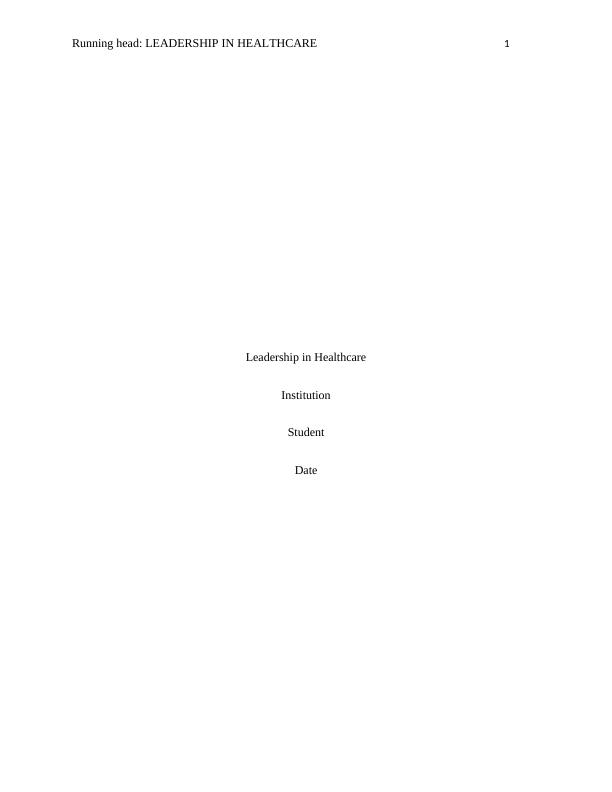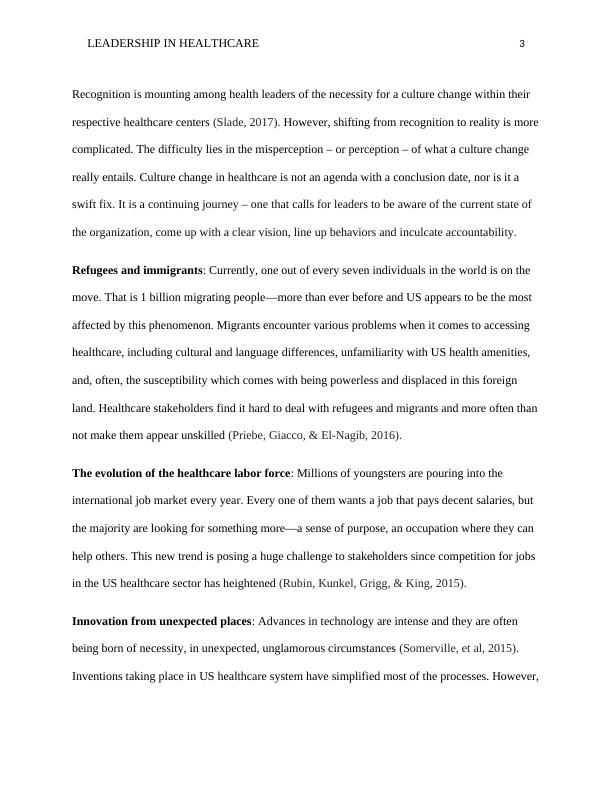Leadership in Healthcare
Added on 2023-04-21
10 Pages2558 Words496 Views
Running head: LEADERSHIP IN HEALTHCARE 1
Leadership in Healthcare
Institution
Student
Date
Leadership in Healthcare
Institution
Student
Date

LEADERSHIP IN HEALTHCARE 2
Assignment 1
Leadership in Healthcare
Due to the immense raise in globalization, health leaders are now more capable of leading people
from diverse backgrounds, diverse outlooks, and diverse educational portfolios. Globalization
has turned the world into a village-like setting where health leaders are now more understanding
and culturally sentient. Furthermore, they are able to lead other health practitioners in providing
services across countries including telemedicine tools such as Tele-radiology and Tele-
diagnostics through electronic methods (Murphy, 2008).
Power inspires health leaders to push towards their goals. Psychologists and leadership experts
believe leaders, in particular transformational leaders, who are inspiring, positive, and who
develop and empower followers, are the most valued, and have a higher performing support staff
or team. Leaders who fail to aspire to motivate or encourage their subjects often endanger the
impact they could have, and as a result, go amiss of their goals (Kumar, & Khiljee, 2016).
According to health leaders, followership enables health practitioners to get in line behind a
program, to be part of a team, to take direction well, and to deliver on what is expected of them
(Mannion, McKimm, & O'Sullivan, 2015). Followership challenges manifest themselves in
unsatisfied customers, lost opportunities, a poor work ethic, bad morale, high costs, weak
competitiveness, product quality issues, and distraction from goals. At extreme cases, weak
followership and weak leadership in healthcare organizations are two sides of the same coin and
the consequences are always similar: organizational disorientation and poor performance.
Assignment 1
Leadership in Healthcare
Due to the immense raise in globalization, health leaders are now more capable of leading people
from diverse backgrounds, diverse outlooks, and diverse educational portfolios. Globalization
has turned the world into a village-like setting where health leaders are now more understanding
and culturally sentient. Furthermore, they are able to lead other health practitioners in providing
services across countries including telemedicine tools such as Tele-radiology and Tele-
diagnostics through electronic methods (Murphy, 2008).
Power inspires health leaders to push towards their goals. Psychologists and leadership experts
believe leaders, in particular transformational leaders, who are inspiring, positive, and who
develop and empower followers, are the most valued, and have a higher performing support staff
or team. Leaders who fail to aspire to motivate or encourage their subjects often endanger the
impact they could have, and as a result, go amiss of their goals (Kumar, & Khiljee, 2016).
According to health leaders, followership enables health practitioners to get in line behind a
program, to be part of a team, to take direction well, and to deliver on what is expected of them
(Mannion, McKimm, & O'Sullivan, 2015). Followership challenges manifest themselves in
unsatisfied customers, lost opportunities, a poor work ethic, bad morale, high costs, weak
competitiveness, product quality issues, and distraction from goals. At extreme cases, weak
followership and weak leadership in healthcare organizations are two sides of the same coin and
the consequences are always similar: organizational disorientation and poor performance.

LEADERSHIP IN HEALTHCARE 3
Recognition is mounting among health leaders of the necessity for a culture change within their
respective healthcare centers (Slade, 2017). However, shifting from recognition to reality is more
complicated. The difficulty lies in the misperception – or perception – of what a culture change
really entails. Culture change in healthcare is not an agenda with a conclusion date, nor is it a
swift fix. It is a continuing journey – one that calls for leaders to be aware of the current state of
the organization, come up with a clear vision, line up behaviors and inculcate accountability.
Refugees and immigrants: Currently, one out of every seven individuals in the world is on the
move. That is 1 billion migrating people—more than ever before and US appears to be the most
affected by this phenomenon. Migrants encounter various problems when it comes to accessing
healthcare, including cultural and language differences, unfamiliarity with US health amenities,
and, often, the susceptibility which comes with being powerless and displaced in this foreign
land. Healthcare stakeholders find it hard to deal with refugees and migrants and more often than
not make them appear unskilled (Priebe, Giacco, & El-Nagib, 2016).
The evolution of the healthcare labor force: Millions of youngsters are pouring into the
international job market every year. Every one of them wants a job that pays decent salaries, but
the majority are looking for something more—a sense of purpose, an occupation where they can
help others. This new trend is posing a huge challenge to stakeholders since competition for jobs
in the US healthcare sector has heightened (Rubin, Kunkel, Grigg, & King, 2015).
Innovation from unexpected places: Advances in technology are intense and they are often
being born of necessity, in unexpected, unglamorous circumstances (Somerville, et al, 2015).
Inventions taking place in US healthcare system have simplified most of the processes. However,
Recognition is mounting among health leaders of the necessity for a culture change within their
respective healthcare centers (Slade, 2017). However, shifting from recognition to reality is more
complicated. The difficulty lies in the misperception – or perception – of what a culture change
really entails. Culture change in healthcare is not an agenda with a conclusion date, nor is it a
swift fix. It is a continuing journey – one that calls for leaders to be aware of the current state of
the organization, come up with a clear vision, line up behaviors and inculcate accountability.
Refugees and immigrants: Currently, one out of every seven individuals in the world is on the
move. That is 1 billion migrating people—more than ever before and US appears to be the most
affected by this phenomenon. Migrants encounter various problems when it comes to accessing
healthcare, including cultural and language differences, unfamiliarity with US health amenities,
and, often, the susceptibility which comes with being powerless and displaced in this foreign
land. Healthcare stakeholders find it hard to deal with refugees and migrants and more often than
not make them appear unskilled (Priebe, Giacco, & El-Nagib, 2016).
The evolution of the healthcare labor force: Millions of youngsters are pouring into the
international job market every year. Every one of them wants a job that pays decent salaries, but
the majority are looking for something more—a sense of purpose, an occupation where they can
help others. This new trend is posing a huge challenge to stakeholders since competition for jobs
in the US healthcare sector has heightened (Rubin, Kunkel, Grigg, & King, 2015).
Innovation from unexpected places: Advances in technology are intense and they are often
being born of necessity, in unexpected, unglamorous circumstances (Somerville, et al, 2015).
Inventions taking place in US healthcare system have simplified most of the processes. However,

End of preview
Want to access all the pages? Upload your documents or become a member.
Related Documents
Effective Leadership in Contemporary Healthcare: Challenges and Solutionslg...
|5
|2289
|337
Importance Of Clinical Governance | Reportlg...
|10
|2253
|34
Leadership Approaches and Continuous Quality Improvement of Teaching in Clinical Practicelg...
|10
|2804
|413
Change Management in Healthcarelg...
|8
|1835
|91
Behavior Change and Leadership Strategy in Healthcare: A Case Study of Mayo Cliniclg...
|5
|799
|108
Diverse and Management Culture : Reportlg...
|5
|987
|38
